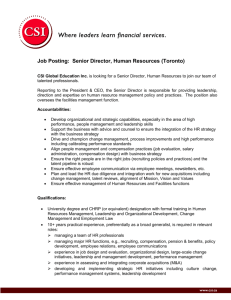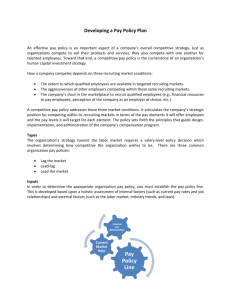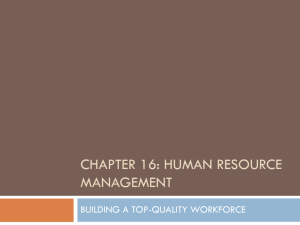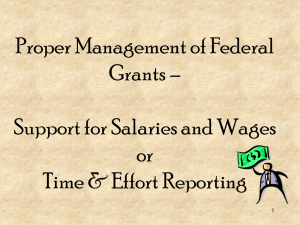Ch 8:Managing Human Resources and Labor Relations
advertisement
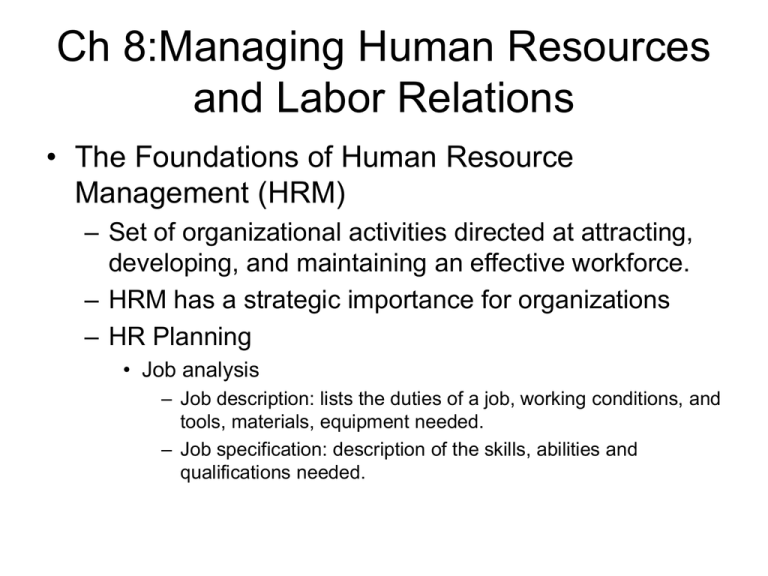
Ch 8:Managing Human Resources and Labor Relations • The Foundations of Human Resource Management (HRM) – Set of organizational activities directed at attracting, developing, and maintaining an effective workforce. – HRM has a strategic importance for organizations – HR Planning • Job analysis – Job description: lists the duties of a job, working conditions, and tools, materials, equipment needed. – Job specification: description of the skills, abilities and qualifications needed. • Forecasting HR Demand and Supply – Forecast both internal and external supply of labor – We can use replacement charts, employee information systems (skills inventory) • Matching HR Supply and Demand Staffing the Organization • Recruiting Human Resources – Recruiting: process of attracting qualified persons to apply for jobs an organization is seeking to fill. • Internal recruiting: considers present employees as candidates for openings • External recruiting: attracting persons outside the organization to apply for jobs • Selecting Human Resources – Application forms: work history, education, other job related data. – Tests: ability, aptitude, knowledge. Sometimes personality and intelligence is also tested. – Interviews: very popular selection device – be prepared!! – Other techniques: health exams, drug tests, check the references etc. Developing the Workforce • Training – on-the-job training: usually informal, train while performing the job – off-the-job training: usually formal, done in a controlled environment – vestibule training: off-the-job training conducted in a simulated environment • Performance appraisal – Evaluation of a employee’s job performance to see if the employee is performing effectively. Compensation and Benefits • Compensation system: set of rewards that organizations provide to individuals in return for their willingness to perform various jobs and tasks within the organization. – Wages and salaries: • Wages: compensation in the form of money paid for time worked. • Salaries: Compensation in the form of money paid for carrying out the responsibilities of the job. – Incentive Programs: special compensation program designed to motivate high performance. – We have: • Individual incentives – E.g., bonus, merit salary system. • Company-wide incentives – E.g., profit-sharing plan, gainsharing plan, pay-forknowledge plan – Benefits Programs: compensation other than wages and salaries. Can be more valuable than wages and salaries. • E.g., retirement plans, health/life insurance, social security payments, vacation, holidays, company car etc. • Containing the costs of benefits??? The Legal Context of HR Management • A HR manager must be knowledgeable about the legal system • Equal employment opportunity – Affirmative action plan, sexual harassment etc. • Other topics – child labor, illegal workers etc, New Challenges in the Workplace • Immigration, global competition and technology are important factors • Managing a diverse workforce – Range of workers’ attitudes, values, and behaviors that differ by gender, race, and ethnicity. • Managing knowledge workers • Contingent workers and temporary employment Dealing with Organized Labor • Labor Union: Group of people working together to achieve job-related goals, such as higher pay, shorter working hours, more job security, greater benefits or better working conditions. • Labor Relations: Process of dealing with employees who are represented by a union. • Collective Bargaining: process by which labor and management negotiate conditions of employment for union-represented workers. • Unions Today: It is declining. Why??? – – – – Composition of the workforce Rise of the service sector Anti-unionization strategies Negotiated concessions Collective Bargaining • Reaching agreement on contract terms = labor contract. • Contract issues: cost of living adjustment (COLA), benefits, job security, other minor issues, and management rights • When Bargaining Fails – Unions Tactics • Strike: labor action in which employees temporarily walk off the job and refuse to work • Picketing: labor action in which workers publicize their grievances at the entrance to the company • Boycott: labor action in which workers refuse to buy the company’s products • Slowdown: labor action in which workers perform jobs at a lower rate. • Management tactics – Lockouts: workers are not allowed into the workplace – Strikebreaker: new workers are hired to replace the striking workers. Sometimes third parties try to help ---with mediation or arbitration. Mediation and Arbitration • Mediation: a neutral third party suggests, but cannot impose, a settlement. • Arbitration: a neutral third party passes a judgment, and thus can impose a settlement.
